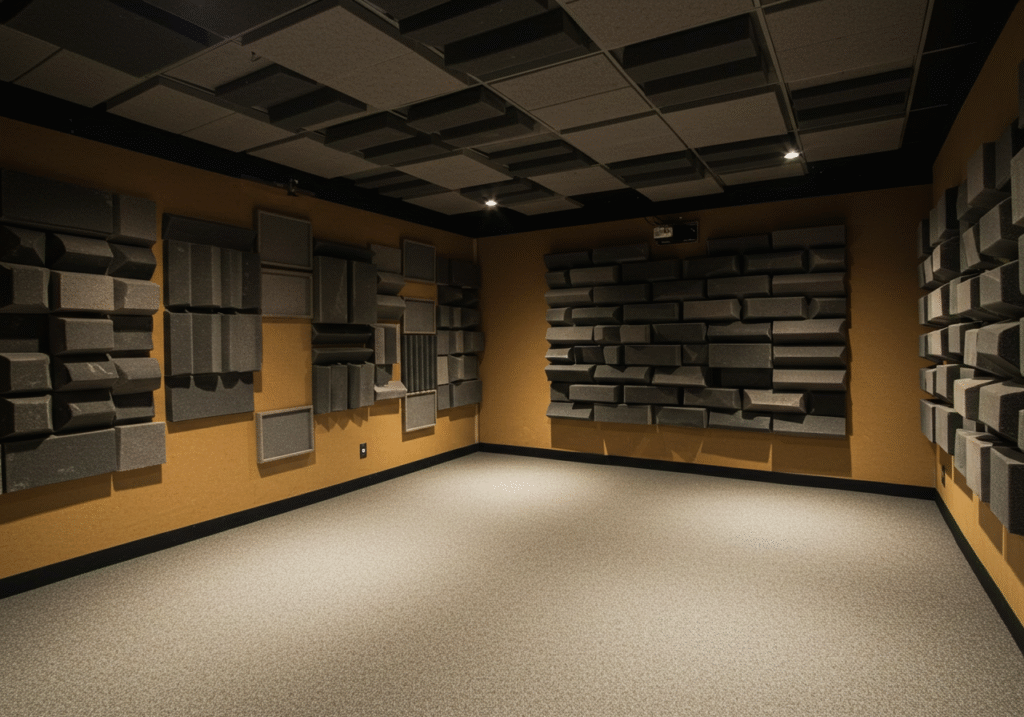Introduction:
Contents
- 1 Introduction:
- 1.1 1. Add Acoustic Panels to Walls
- 1.2 2. Use Fiberglass Insulation Inside Walls
- 1.3 3. Install a Second Layer of Drywall
- 1.4 4. Apply Acoustic Sealant to Gaps and Cracks
- 1.5 5. Add Resilient Channels or Clips
- 1.6 6. Use Mass-Loaded Vinyl Barriers
- 1.7 7. Add Underlayment for Floors
- 1.8 8. Use Foam Tiles on Ceilings
- 1.9 9. Install Vibration Damping Materials
- 1.10 10. Combine Multiple Soundproofing Methods
- 2 Final Thoughts:
Soundproofing is very important when you want quiet in your home. Noise from other rooms or outside can make life stressful. By using simple methods, you can reduce noise and make your home more comfortable. These ideas are easy and practical for anyone to follow.
1. Add Acoustic Panels to Walls
Acoustic panels are a great way to reduce noise in a room. They help in sound absorption and stop echoes from spreading. You can install these panels on walls and ceilings easily without heavy construction work. Choose panels with good insulation to make the space quiet and peaceful.
2. Use Fiberglass Insulation Inside Walls
Fiberglass insulation works very well for soundproofing because it blocks noise inside walls. It also helps in controlling temperature, which is an added benefit. You can install it during construction or as a retrofit for better noise reduction. This method is simple and gives long-lasting results.
3. Install a Second Layer of Drywall
Adding another layer of drywall increases the mass of the wall, which helps block sound. For even better results, use a damping compound between the layers to stop vibration. This method reduces noise coming from both sides of the wall. It is very effective and does not require major changes.
4. Apply Acoustic Sealant to Gaps and Cracks
Small gaps and cracks in walls and ceilings allow sound to pass through. Use an acoustic sealant to fill these spaces and block noise. This is an easy and low-cost way to improve soundproofing. It works best when used with other methods like insulation and panels.
5. Add Resilient Channels or Clips
Resilient channels and clips help separate drywall from wall studs or joists. This creates an isolation layer that stops vibration and reduces noise transfer. They are very useful in ceilings and walls for better soundproofing. This method works well during construction or renovation.
6. Use Mass-Loaded Vinyl Barriers
Mass-loaded vinyl is a heavy material that blocks sound effectively. You can place it inside walls, under floors, or behind ceilings. It is thin but very dense, which makes it good for noise reduction. This is one of the most powerful methods for quiet spaces.
7. Add Underlayment for Floors
Underlayment is a soft material placed under flooring to reduce impact noise. It works well for homes with multiple floors to block footsteps and vibration. Choose acoustic underlayment for better sound absorption. This method is simple and improves comfort.
8. Use Foam Tiles on Ceilings
Foam tiles are great for reducing echo and absorbing noise. They are lightweight and easy to install on ceilings without special tools. These tiles work well in rooms where sound travels too much. They make the room quieter and more pleasant.
9. Install Vibration Damping Materials
Noise often comes from vibration passing through walls, floors, and ceilings. Damping materials stop this vibration and make the room quiet. You can use damping sheets or compounds between layers of construction material. This method gives very good sound reduction.
10. Combine Multiple Soundproofing Methods
The best results come when you use more than one soundproofing technique. For example, use insulation inside walls and add acoustic panels outside. Seal all gaps and add damping materials for extra noise control. This combination creates a quiet and peaceful environment.
Final Thoughts:
Soundproofing is not hard when you use the right methods. Simple changes like insulation, panels, and sealant can make a big difference. You do not need to spend too much money to enjoy a quiet home. Just follow these easy steps and your space will feel calm and comfortable.

